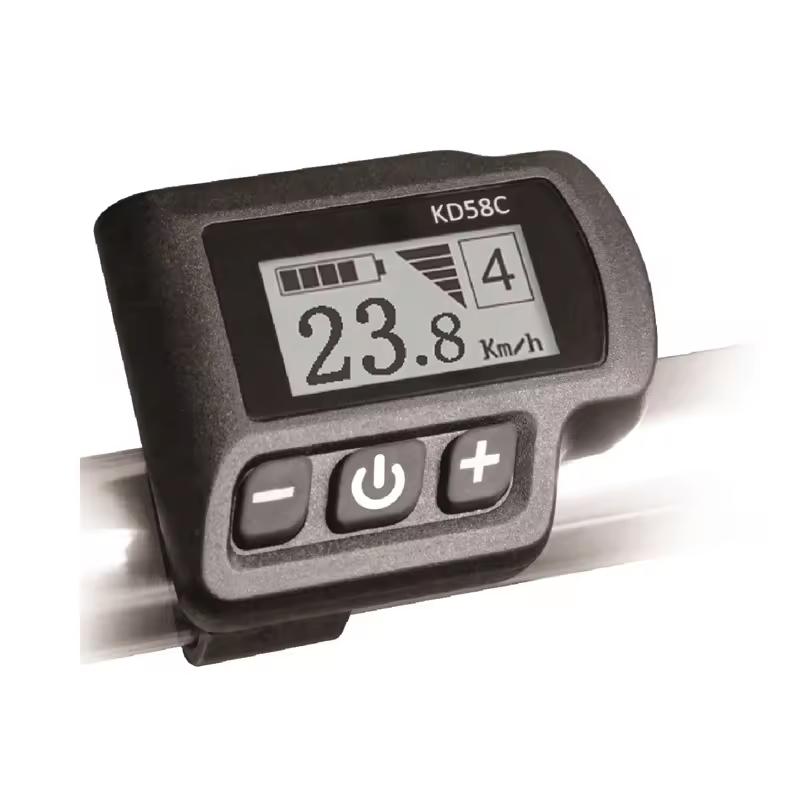Why Are Bicycle LCD Displays Transforming the Future of Smart Cycling?
2025-10-15
A Bicycle LCD Display is an advanced digital interface that allows riders to monitor, control, and optimize their cycling experience in real time. Positioned on the handlebar, it connects to the e-bike’s controller and various sensors to present essential riding data—speed, distance, battery level, power output, and more. As electric bicycles continue to dominate the green mobility trend, the LCD display has evolved from a simple dashboard into a central hub for smart cycling management.
Modern cycling emphasizes data-driven riding. From daily commuters to professional cyclists, users increasingly rely on clear, responsive, and durable displays that perform under diverse weather and lighting conditions. The Bicycle LCD not only improves usability but also enhances safety by providing instant feedback, navigation, and performance insights.
What Are the Key Features and Technical Specifications of a Bicycle LCD Display?
To meet global cycling demands, a professional-grade Bicycle LCD integrates precision engineering, smart electronics, and user-centric design. Below is a list of the most critical specifications typically found in a top-tier model:
| Parameter | Specification Details |
|---|---|
| Display Type | High-contrast LCD / TFT color screen |
| Screen Size | 2.4 to 3.5 inches |
| Resolution | 320×240 / 480×272 pixels |
| Backlight Brightness | Adjustable (automatic light sensor optional) |
| Operating Voltage | 24V / 36V / 48V / 52V systems |
| Communication Protocol | UART / CAN bus / Bluetooth |
| Waterproof Rating | IP65 to IP67 (dustproof and splash-resistant) |
| Operating Temperature | -20°C to 70°C |
| Material | High-strength ABS or polycarbonate with UV protection |
| Interface Options | Speed, PAS level, battery indicator, trip distance, error code |
| Mounting Method | Handlebar fixed bracket, quick-release option |
| Power Consumption | Low (<1W) |
| Optional Features | USB charging port, navigation, mobile app synchronization |
Why these specs matter:
Each technical feature contributes to performance longevity and rider safety. For instance, a high IP rating ensures reliability under rain or mud; CAN bus communication enhances data accuracy between controller and motor; and adjustable backlight supports readability in any light condition.
Why Is the Bicycle LCD Crucial for Modern E-Bikes and Smart Mobility?
The value of a Bicycle LCD extends far beyond displaying numbers. It acts as the digital nerve center for e-bikes, integrating information and control in one interface.
1. Real-Time Performance Monitoring
Riders can instantly view speed, cadence, trip distance, battery life, and motor power output—essential metrics for energy management. This data allows users to adjust their riding style, conserve power, and extend battery range efficiently.
2. Intelligent Control Integration
Modern displays allow seamless control over pedal-assist levels, lighting systems, and regenerative braking. Some models synchronize with smartphone apps or GPS navigation systems, transforming ordinary rides into connected journeys.
3. Safety and Visibility
Advanced LCDs include warning systems for low voltage, system errors, or motor overheating. With a bright and anti-glare screen, cyclists stay informed without distraction, ensuring better road awareness.
4. Aesthetic and Functional Design
Beyond functionality, the slim, ergonomic design enhances the bike’s appearance. Anti-fog coatings and impact-resistant casings maintain long-term clarity and performance under tough terrain.
5. Sustainability and Power Efficiency
Compared to older LED meters, LCD displays consume minimal power, contributing to a longer battery life and overall energy efficiency—an essential factor for eco-conscious riders.
How Does a Bicycle LCD Work and What Makes It Different from Other Display Types?
Understanding the working principle of a Bicycle LCD reveals how it transforms electrical signals into meaningful visual feedback.
-
Data Input:
Sensors on the e-bike (speed, torque, battery, motor) send signals to the controller. -
Processing Unit:
The controller processes this data and communicates it through UART or CAN bus protocols to the LCD. -
Display Rendering:
The LCD converts these signals into visual icons, numbers, or animations on the screen. TFT displays offer richer color and higher contrast, ideal for sunlight readability. -
User Interaction:
Buttons or touch-sensitive areas allow riders to change modes, view trip history, or adjust assist levels instantly. -
Energy Optimization:
The system uses power-saving logic—turning off automatically after inactivity or dimming under low light to extend battery performance.
How it differs from LED or OLED displays:
-
LCD is cost-effective, long-lasting, and less prone to burn-in.
-
OLED offers sharper contrast but at a higher power cost.
-
TFT-LCD balances color performance and energy use, making it the most popular for bicycles today.
What Are the Current Market Trends and Future Outlook for Bicycle LCD Technology?
The global e-bike market is growing exponentially, driven by urbanization, sustainability goals, and health-conscious lifestyles. The Bicycle LCD market follows this trend with rapid innovation.
1. Integration with IoT and Smart Apps
Next-generation displays now link with mobile apps, cloud services, and wearable devices. Riders can analyze post-ride data, get firmware updates, or customize interface layouts directly from smartphones.
2. Enhanced User Interfaces
Manufacturers are adopting touch-sensitive TFT panels and voice-controlled features. Multi-language menus and app synchronization enhance accessibility worldwide.
3. Eco-Friendly Manufacturing
Brands emphasize recyclable materials, energy-efficient circuits, and solar-compatible systems to align with green mobility policies.
4. Predictive Maintenance and AI Diagnostics
Upcoming LCDs will integrate diagnostic algorithms capable of detecting potential system failures in advance, reducing downtime and repair costs.
5. Customization and Branding
As competition intensifies, manufacturers offer customizable layouts and color schemes—allowing brands and users to personalize their interface aesthetics.
Overall, the Bicycle LCD is transitioning from a passive display to an intelligent mobility assistant, shaping the future of connected cycling ecosystems.
Common FAQs About Bicycle LCD Displays
Q1: What should cyclists consider when choosing a Bicycle LCD display?
A: Key factors include voltage compatibility, screen brightness, communication protocol (UART or CAN), waterproof rating, and ease of installation. Riders should also assess whether the display supports essential metrics like speed, battery, PAS level, and system error codes. High-end displays with color TFT panels and mobile connectivity are ideal for riders who prioritize data precision and aesthetics.
Q2: How to maintain and prolong the lifespan of a Bicycle LCD?
A: Avoid exposure to direct sunlight for long hours when parked, clean the screen with a soft microfiber cloth, and ensure cable connectors remain sealed against moisture. For electric bikes, regular firmware updates through the controller or app help maintain performance stability and data accuracy.
How Hoshineo Shapes the Future of Bicycle LCD Innovation
As the cycling world accelerates toward smart, connected, and sustainable mobility, the Bicycle LCD has emerged as a pivotal technology uniting performance, safety, and aesthetics. From efficient data communication to real-time performance control, it enables cyclists to ride smarter and safer.
Leading innovators like Hoshineo are setting benchmarks in design precision, user interface innovation, and eco-friendly production. Their Bicycle LCD series delivers high-resolution clarity, adaptive brightness, waterproof durability, and seamless connectivity—engineered for riders who demand the best.
To discover more about advanced Bicycle LCD solutions and tailor-made OEM/ODM options, contact us for detailed consultation and partnership opportunities. Hoshineo continues to redefine smart cycling technology—one display at a time.



